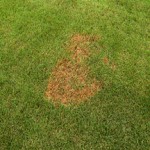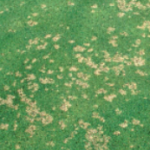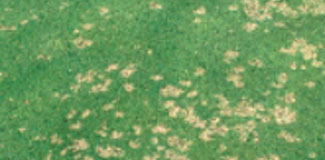Recently, I’ve visited yards in the area that were suffering from two fungal diseases: Large Patch and Dollar Spot. Both of these diseases are stimulated by high humidity caused by recent rains.
Large Patch Fungus
Large patch fungus can infect our four warm season grasses: bermuda, zoysia, St. Augustine and centipede.
Signs and Symptoms: The first symptoms are dinner plate sized yellow patches bordered with a reddish brown color of grass moving into the green grass areas at the rate of 4 to 12 inches per month. By summer these patches may be 15 to 20 feet in diameter. There are no spots on the leaves but the base of the leaf where it enters the sheaf contains a soft dark rot.
Symptoms: The first symptoms are dinner plate sized yellow patches bordered with a reddish brown color of grass moving into the green grass areas at the rate of 4 to 12 inches per month. By summer these patches may be 15 to 20 feet in diameter. There are no spots on the leaves but the base of the leaf where it enters the sheaf contains a soft dark rot.
Cultural Management: Mow at the upper range of recommended cutting heights, improve drainage, and manage thatch build-up.
Chemical Management: Fungicides containing thiophanate-methyl, azoxystrobin, chlorothalonil can be used for preventative control. Apply one of these fungicides at first occurrence in spring or summer and an alternate fungicide application in October or November.
Dollar Spot Fungus
Dollar spot fungus begins as an isolated stray spot varying from two to five inches in diameter. It is reproduced not from spores like most fungi, but by the main structure of the fungus called the mycelium. Parts of the mycelium may be spread throughout the remaining lawn via lawn mower blades.
 Signs and Symptoms: Look for cobwebs early in the morning on your grass. If the grass is straw-colored beneath the cobweb mass, it is dollar spot. If the grass is green beneath the mass, don’t worry, it is a spider web caused by a very small spider. A closer examination of the plant’s leaf will reveal a straw-colored lesion, outlined by a reddish brown border. This lesion will elongate longitudinally with the blade and cross the width of the blade, leaving a green basal portion and a green blade tip.
Signs and Symptoms: Look for cobwebs early in the morning on your grass. If the grass is straw-colored beneath the cobweb mass, it is dollar spot. If the grass is green beneath the mass, don’t worry, it is a spider web caused by a very small spider. A closer examination of the plant’s leaf will reveal a straw-colored lesion, outlined by a reddish brown border. This lesion will elongate longitudinally with the blade and cross the width of the blade, leaving a green basal portion and a green blade tip.
Disease Cycle: The fungus survives winter in the grass thatch, and begins to grow upward during the spring feeding on the water droplets exuded from the tips of the grass blades. These droplets are called guttation droplets and are loaded with plant sugars that feed the fungus. After feeding on the water droplets, the fungus inserts its mycelium into the leaf and feeds on the leaf sap causing the straw color as stated above.
Cultural Management: Fertilize grass to stimulate leaf growth and mow high to cut tips of grass blades with bag attachment. Water deeply and infrequently.
Chemical Management: Dollar spot responds well to fungicides such as thiophanate-methyl, azoxystrobin, or mancozeb. Garden stores can assist you in identifying the trade name fungicides.
For best results, consult a landscape professional.





